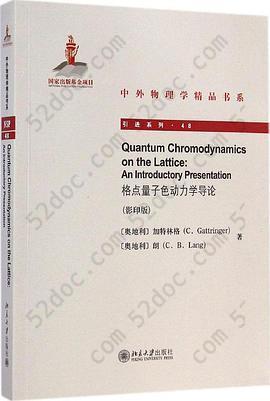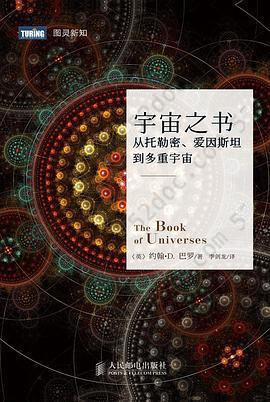注重体验与质量的电子书资源下载网站
分类于: 编程语言 互联网
简介

格点量子色动力学导论(影印版): Quantun Chromodynamics on the Lattice : An Introductory Presentation 豆 0.0分
资源最后更新于 2020-09-21 15:59:15
作者:C.Gattringer
出版社:北京大学出版社
出版日期:2014-01
ISBN:9787301248966
文件格式: pdf
简介· · · · · ·
《格点量子色动力学导论(英文影印版)》讲述了格点场论在量子色动力学中的应用。本书首先讲述了格点路径积分,之后讲述了纯规范理论的格点化和数值模拟。然后,本书讲述了格点上的费米子、强子谱、手征对称性等内容。对于动力学费米子和重正化群也做了深入的探讨。最后,本书还讲述了对强子结构和温度、化学势的格点场论处理。本书适合量子场论和粒子物理领域的研究者和研究生阅读。
目录
1 The path integral on the lattice
1.1 Hilbert space and propagation in Euclidean time
1.1.1 Hilbert spaces
1.1.2 Remarks on Hilbert spaces in particle physics
1.1.3 Euclidean correlators
1.2 The path integral for a quantum mechanical system
1.3 The path integral for a scalar field theory
1.3.1 The Klein—Gordon field
1.3.2 Lattice regularization of the Klein—Gordon Hamiltonian
1.3.3 The Euclidean time transporter for the free case,
1.3.4 Treating the interaction term with the Trotter formula
1.3.5 Path integral representation for the partition function
1.3.6 Including operators in the path integral
1.4 Quantization with the path integral
1.4.1 Different discretizations of the Euclidean action
1.4.2 The path integral as a quantization prescription
1.4.3 The relation to statistical mechanics
References
2 QCD on the lattice—a first look
2.1 The QCD action in the continuum
2.1.1 Quark and gluon fields
2.1.2 The fermionic part of the QCD action
2.1.3 Gauge invariance of the fermion action
2.1.4 The gluon action
2.1.5 Color components of the gauge field
2.2 Naive discretization of fermions
2.2.1 Discretization of free fermions
2.2.2 Introduction of the gauge fields as link variables
2.2.3 Relating the link variables to the continuum gauge fields
2.3 The Wilson gauge action
2.3.1 Gauge—invariant objects built with link variables
2.3.2 The gauge action
2.4 Formal expression for the QCD lattice path integral
2.4.1 The QCD lattice path integral
References
3 Pure gauge theory on the lattice
3.1 Haar measure
3.1.1 Gauge field measure and gauge invariance
3.1.2 Group integration measure
3.1.3 A few integrals for SU(3)
3.2 Gauge invariance and gauge fixing
3.2.1 Maximal trees
3.2.2 Other gauges
3.2.3 Gauge invariance of observables
3.3 Wilson and Polyakov loops
3.3.1 Definition of the Wilson loop
3.3.2 Temporal gauge
3.3.3 Physical interpretation of the Wilson loop
3.3.4 Wilson line and the quark—antiquark pair
3.3.5 Polyakov loop
3.4 The static quark potential
3.4.1 Strong coupling expansion of the Wilson loop
3.4.2 The Coulomb part of the static quark potential
3.4.3 Physical implications of the static QCD potential
3.5 Setting the scale with the static potential
3.5.1 Discussion of numerical data for the static potential
3.5.2 The Sommer parameter and the lattice spacing
3.5.3 Renormalization group and the running coupling
3.5.4 The true continuum limit
3.6 Lattice gauge theory with other gauge groups
References
4 Numerical simulation of pure gauge theory
4.1 The Monte Carlo method
4.1.1 Simple sampling and importance sampling
4.1.2 Markov chains
4.1.3 Metropolis algorithm—general idea
4.1.4 Metropolis algorithm for Wilson’s gauge action
4.2 Implementation of Monte Carlo algorithms for SU(3)
4.2.1 Representation of the link variables
4.2.2 Boundary conditions
4.2.3 Generating a candidate link for the Metropolis update
4.2.4 A few remarks on random numbers
4.3 More Monte Carlo algorithms
4.3.1 The heat bath algorithm
4.3.2 Overrelaxation
4.4 Running the simulation
4.4.1 Initialization
4.4.2 Equilibration updates
4.4.3 Evaluation of the observables
4.5 Analyzing the data
4.5.1 Statistical analysis for uncorrelated data
4.5.2 Autocorrelation
4.5.3 Techniques for smaller data sets
4.5.4 Some numerical exercises
References
5 Fermions on the lattice
5.1 Fermi statistics and Grassmann numbers
5.1.1 Some new notation
5.1.2 Fermi statistics
5.1.3 Grassmann numbers and derivatives
5.1.4 Integrals over Grassmann numbers
5.1.5 Gaussian integrals with Grassmann numbers
5.1.6 Wick’s theorem
5.2 Fermion doubling and Wilson’s fermion action
5.2.1 The Dirac operator on the lattice
5.2.2 The doubling problem
5.2.3 Wilson fermions
5.3 Fermion lines and hopping expansion
5.3.1 Hopping expansion of the quark propagator
5.3.2 Hopping expansion for the fermion determinant
5.4 Discrete symmetries of the Wilson action
5.4.1 Charge conjugation
5.4.2 Parity and Euclidean refiections
5.4.3 γ5—hermiticity
References
6 Hadron spectroscopy
6.1 Hadron interpolators and correlators
6.1.1 Meson interpolators
6.1.2 Meson correlators
6.1.3 Interpolators and correlators for baryons
6.1.4 Momentum projection
6.1.5 Final formula for hadron correlators
6.1.6 The quenched approximation
6.2 Strategy of the calculation
6.2.1 The need for quark sources
6.2.2 Point source or extended source?
6.2.3 Extended sources
6.2.4 Calculation of the quark propagator
6.2.5 Exceptionalconfigurations
6.2.6 Smoothing of gauge configurations
6.3 Extracting hadron masses
6.3.1 Effective mass curves
6.3.2 Fitting the correlators
6.3.3 The calculation of excited states
6,4 Finalizing the results for the hadron masses
6.4.1 Discussion of some raw data
6.4.2 Setting the scale and the quark mass parameters
6.4.3 Various extrapolations
6.4.4 Some quenched results
References
7 Chiral symmetry on the lattice
7.1 Chiral symmetry in continuum QCD
7.1.1 Chiral symmetry for a single flavor
7.1.2 Several fiavors
7,1.3 Spontaneous breaking of chiral symmetry
7.2 Chiral symmetry and the lattice
7,2.1 Wilson fermions and the Nielsen—Ninomiya theorem
7.2.2 The Ginsparg—Wilson equation
7.2.3 Chiral symmetry on the lattice
7.3 Consequences of the Gmsparg—Wilson equation
7.3.1 Spectrum of the Dirac operator
7.3.2 Index theorem
7.3.3 The axial anomaly
7.3.4 The chiral condensate
7.3.5 The Banks—Casher relation
7.4 The overlap operator
7.4.1 Definition of the overlap operator
7.4.2 Locality properties of chiral Dirac operators
7.4.3 Numerical evaluation of the overlap operator
References
……
8 Dynamical fermions
9 Symanzik improvement and RG actions
10 More about lattice fermions
11 Hadron structure
12 Temperature and chemical potential
A Appendix
Index
1.1 Hilbert space and propagation in Euclidean time
1.1.1 Hilbert spaces
1.1.2 Remarks on Hilbert spaces in particle physics
1.1.3 Euclidean correlators
1.2 The path integral for a quantum mechanical system
1.3 The path integral for a scalar field theory
1.3.1 The Klein—Gordon field
1.3.2 Lattice regularization of the Klein—Gordon Hamiltonian
1.3.3 The Euclidean time transporter for the free case,
1.3.4 Treating the interaction term with the Trotter formula
1.3.5 Path integral representation for the partition function
1.3.6 Including operators in the path integral
1.4 Quantization with the path integral
1.4.1 Different discretizations of the Euclidean action
1.4.2 The path integral as a quantization prescription
1.4.3 The relation to statistical mechanics
References
2 QCD on the lattice—a first look
2.1 The QCD action in the continuum
2.1.1 Quark and gluon fields
2.1.2 The fermionic part of the QCD action
2.1.3 Gauge invariance of the fermion action
2.1.4 The gluon action
2.1.5 Color components of the gauge field
2.2 Naive discretization of fermions
2.2.1 Discretization of free fermions
2.2.2 Introduction of the gauge fields as link variables
2.2.3 Relating the link variables to the continuum gauge fields
2.3 The Wilson gauge action
2.3.1 Gauge—invariant objects built with link variables
2.3.2 The gauge action
2.4 Formal expression for the QCD lattice path integral
2.4.1 The QCD lattice path integral
References
3 Pure gauge theory on the lattice
3.1 Haar measure
3.1.1 Gauge field measure and gauge invariance
3.1.2 Group integration measure
3.1.3 A few integrals for SU(3)
3.2 Gauge invariance and gauge fixing
3.2.1 Maximal trees
3.2.2 Other gauges
3.2.3 Gauge invariance of observables
3.3 Wilson and Polyakov loops
3.3.1 Definition of the Wilson loop
3.3.2 Temporal gauge
3.3.3 Physical interpretation of the Wilson loop
3.3.4 Wilson line and the quark—antiquark pair
3.3.5 Polyakov loop
3.4 The static quark potential
3.4.1 Strong coupling expansion of the Wilson loop
3.4.2 The Coulomb part of the static quark potential
3.4.3 Physical implications of the static QCD potential
3.5 Setting the scale with the static potential
3.5.1 Discussion of numerical data for the static potential
3.5.2 The Sommer parameter and the lattice spacing
3.5.3 Renormalization group and the running coupling
3.5.4 The true continuum limit
3.6 Lattice gauge theory with other gauge groups
References
4 Numerical simulation of pure gauge theory
4.1 The Monte Carlo method
4.1.1 Simple sampling and importance sampling
4.1.2 Markov chains
4.1.3 Metropolis algorithm—general idea
4.1.4 Metropolis algorithm for Wilson’s gauge action
4.2 Implementation of Monte Carlo algorithms for SU(3)
4.2.1 Representation of the link variables
4.2.2 Boundary conditions
4.2.3 Generating a candidate link for the Metropolis update
4.2.4 A few remarks on random numbers
4.3 More Monte Carlo algorithms
4.3.1 The heat bath algorithm
4.3.2 Overrelaxation
4.4 Running the simulation
4.4.1 Initialization
4.4.2 Equilibration updates
4.4.3 Evaluation of the observables
4.5 Analyzing the data
4.5.1 Statistical analysis for uncorrelated data
4.5.2 Autocorrelation
4.5.3 Techniques for smaller data sets
4.5.4 Some numerical exercises
References
5 Fermions on the lattice
5.1 Fermi statistics and Grassmann numbers
5.1.1 Some new notation
5.1.2 Fermi statistics
5.1.3 Grassmann numbers and derivatives
5.1.4 Integrals over Grassmann numbers
5.1.5 Gaussian integrals with Grassmann numbers
5.1.6 Wick’s theorem
5.2 Fermion doubling and Wilson’s fermion action
5.2.1 The Dirac operator on the lattice
5.2.2 The doubling problem
5.2.3 Wilson fermions
5.3 Fermion lines and hopping expansion
5.3.1 Hopping expansion of the quark propagator
5.3.2 Hopping expansion for the fermion determinant
5.4 Discrete symmetries of the Wilson action
5.4.1 Charge conjugation
5.4.2 Parity and Euclidean refiections
5.4.3 γ5—hermiticity
References
6 Hadron spectroscopy
6.1 Hadron interpolators and correlators
6.1.1 Meson interpolators
6.1.2 Meson correlators
6.1.3 Interpolators and correlators for baryons
6.1.4 Momentum projection
6.1.5 Final formula for hadron correlators
6.1.6 The quenched approximation
6.2 Strategy of the calculation
6.2.1 The need for quark sources
6.2.2 Point source or extended source?
6.2.3 Extended sources
6.2.4 Calculation of the quark propagator
6.2.5 Exceptionalconfigurations
6.2.6 Smoothing of gauge configurations
6.3 Extracting hadron masses
6.3.1 Effective mass curves
6.3.2 Fitting the correlators
6.3.3 The calculation of excited states
6,4 Finalizing the results for the hadron masses
6.4.1 Discussion of some raw data
6.4.2 Setting the scale and the quark mass parameters
6.4.3 Various extrapolations
6.4.4 Some quenched results
References
7 Chiral symmetry on the lattice
7.1 Chiral symmetry in continuum QCD
7.1.1 Chiral symmetry for a single flavor
7.1.2 Several fiavors
7,1.3 Spontaneous breaking of chiral symmetry
7.2 Chiral symmetry and the lattice
7,2.1 Wilson fermions and the Nielsen—Ninomiya theorem
7.2.2 The Ginsparg—Wilson equation
7.2.3 Chiral symmetry on the lattice
7.3 Consequences of the Gmsparg—Wilson equation
7.3.1 Spectrum of the Dirac operator
7.3.2 Index theorem
7.3.3 The axial anomaly
7.3.4 The chiral condensate
7.3.5 The Banks—Casher relation
7.4 The overlap operator
7.4.1 Definition of the overlap operator
7.4.2 Locality properties of chiral Dirac operators
7.4.3 Numerical evaluation of the overlap operator
References
……
8 Dynamical fermions
9 Symanzik improvement and RG actions
10 More about lattice fermions
11 Hadron structure
12 Temperature and chemical potential
A Appendix
Index








